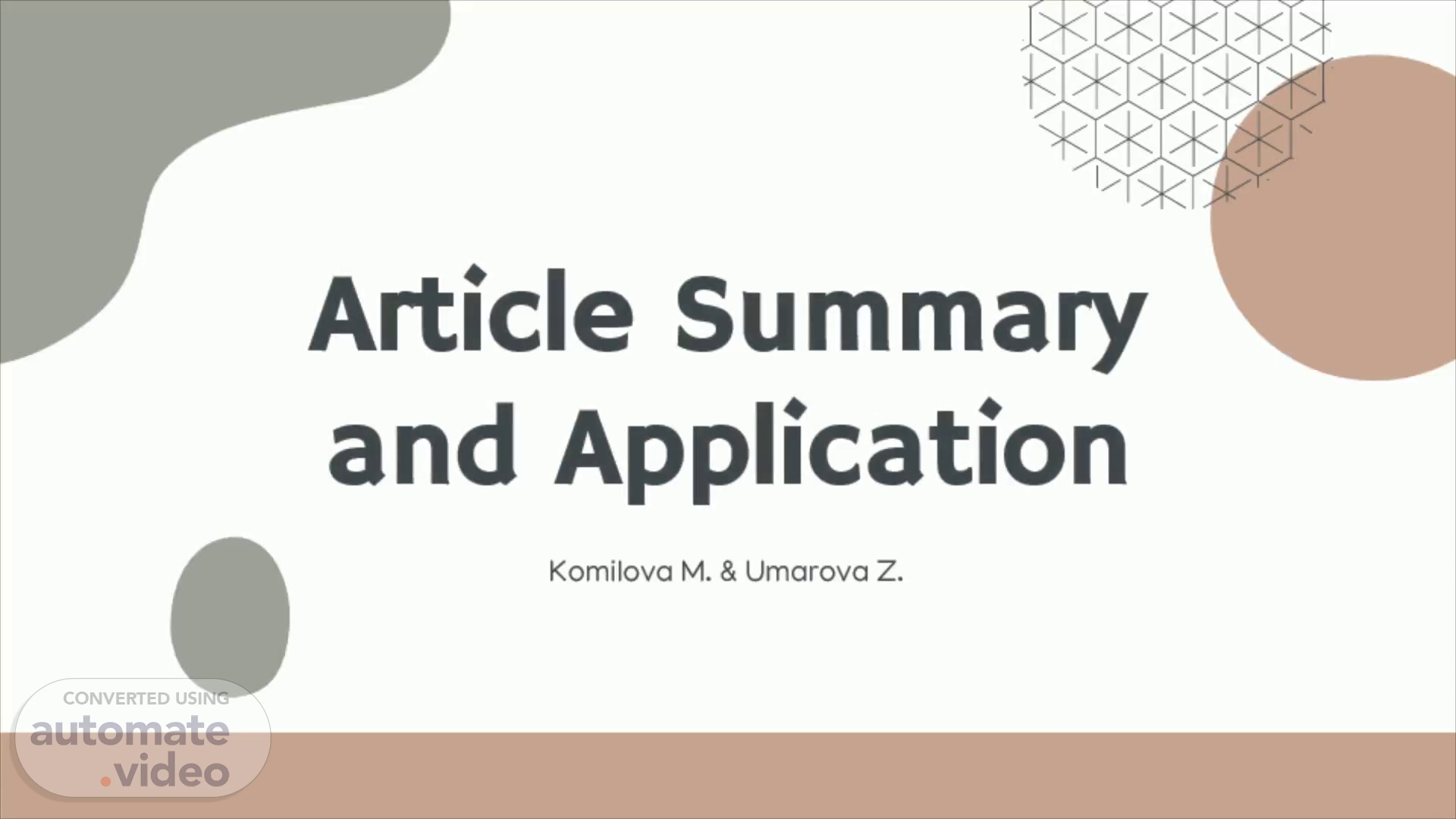
Article Summary and Application
Scene 1 (0s)
Article Summary and Application. Komilova M. & Umarova Z..
Scene 2 (7s)
Watch the video and guess the topic. @ 00.
Scene 3 (2m 28s)
Queering ESL Teaching: Pedagogical and Materials Creation Issues Joshua M. Paiz.
Scene 4 (2m 36s)
1. Introduction 2. Bringing the Queer into TESOL 3. Heteronormativity in language classrooms 4. Queering the ESL classroom: - What Does Queering the Classroom Mean? - Queering Teacher Preparation - Queering Classroom Materials 5. Application 6. Conclusion 7. Reference.
Scene 5 (2m 51s)
Queering ESL Teaching: Pedagogical and Materials Creation Issues.
Scene 6 (3m 3s)
Brief Summary. The article seeks to explore how English as a second language (ESL) classrooms can be meaningfully queered to create a safer and more respectful spaces for students to engage with lesbian, gay, bisexual, and transgender issues in a second language..
Scene 7 (3m 18s)
What does Queering the ESL classroom mean?. It involves the deployment of pedagogical strategies and curricular materials that interrogate a ll sexualities and their sociocultural relevance in a respectful and critical manner in an attempt to create more welcoming and representative classroom, one that may further facilitate language learning. Queer issues in TESOL and applied linguistics were introduced by Norton to the field in 1997..
Scene 8 (3m 36s)
Bringing the Queer into TESOL. Nelson (1993) was among the first to challenge heteronormative view of the language classroom. Heteronormativity – an attitude that heterosexuality is the only normal and natural expression of sexuality. I t states that sexual and marital relations are most fitting between two people of opposite genders (NOT the same). Later she created an early sketch of “gay-friendly pedagogies” (1999) to equip students: To perform their own sexual identities in linguistically meaningful contexts To communicate with LGBT individuals in their daily lives To parse LGBT identities that they encounter in popular media..
Scene 9 (4m 2s)
Heteronormativity in langauge classrooms. - heteronormativity issues associated with a position of nonengagement toward LGBT issues in the language classrooms..
Scene 10 (4m 16s)
Teacher: describe your boyfriend/girlfriend A male student: ... my boyfriend is … Result: teacher corrects the forms to the feminine and skip his performance..
Scene 11 (4m 31s)
E xamination of classroom materials. LGBT identities in language textbooks: De Vincenti, Giovanangeli, and Ward (2007) – LGBT topics in commercially available classroom materials targeted at French, Italian, and Japanese university-level language classrooms. Findings: LGBT identities were underrepresented in the texts Example: a male gay’s identity was judged due to his HIV serostatus rather than other traits of his personality (French classroom material)..
Scene 12 (4m 50s)
Queering the ESL classroom. abstract. Queer is something that hovers at the limits of articulation” ( Helly&Parker , 2011).
Scene 13 (5m 3s)
Queering the classroom.. Sexual identities can become salient during educational interventions and they go beyond mere sex acts; One’s sexual identity can be shaped, mediated and interacted with other different social identities when additional language is required; “Sexual identity maybe central, intended focus of study or an anticipated theme that nonetheless seems worthy for pursuing” (Harrison, 2011, p6); It may involve the perspectives of teacher preparation and material creation; Sharing one’s own life experiences minimize fears of negative social, educational, workplace consequences..
Scene 14 (5m 29s)
Queering Teacher Preparation Lack of LGBT-related topics To train straight teachers to queer their practice Interrogate social constructions of all identities Scaffolding activities Activation of students’ prior knowledge To develop lessons plains in various ways Guide students through reflective exercises considering their use of language Heteronormative assumptions.
Scene 15 (5m 44s)
made for free at coggle.it Queer popular media into the classroom is not enough because the LGBT representations in TV and cinema, particularly in the USA, tend to stereotype or whitewash LGBT identities. (Paiz, 2015) Spending time to prepare commercially reliable materials QUEERING CLASSROOM MATERIALS Encourage students to engage with the texts in a way that questions the vaious identities presented in them Materials need to support a queer- inquiry based pedagogy, encourages the interrogation of heteranormative view such as sexuality is binaryand nonchanging (Nelson, 2006)..
Scene 16 (6m 5s)
Classroom application. Case study: Imagine you are a teacher who is conducting an EFL lesson at secondary school with 11 graders. There is given a text about “Family”, and it includes how families are formed and relationships, members of the family and so on. You asked your learners to read the text and then try to describe their dream family. AND the problem is that there is two pupils who are from LGBT community. How would you handle the classroom not offending all identities to participate and express their ideas. What would you do differently? Think about 2 mins and come up with possible solution that you can do in this situation as a teacher..
Scene 17 (6m 35s)
Ask students to actively imagine nontraditional family structures and how they may be different from and similar to those represented in the text. Then teacher can share various students’ perspectives and compare and contrast normal family and the ones they imagined (nontraditional). Through doing this, teachers can create more safer and welcoming place for students who are from queer community..
Scene 18 (6m 54s)
Applying only heteronormative discourses in ESL/EFL classrooms can be problematic because of the possibly negative impacts on language acquisition processes. That is, it can serve to silence or alienate both teachers and students whose self-identity are members of the LGBT communities. Therefore, queering the ESL/EFL classroom can be one way to help redress these concerns and to create a more welcoming environment – one that is conducive to navigating the complexities of language learning and identity-related issues in a foreign/second language and/or national context..
Scene 19 (7m 19s)
Joshua, M, P. (2017). Queering ESL Teaching: Pedagogical and Material Creation Issues. www.google.com. www.coggleit . com. https:// youtu.be/58od0RlBIjY.
Scene 20 (7m 33s)
Thank you for attention! If you have questions, you are welcome!.